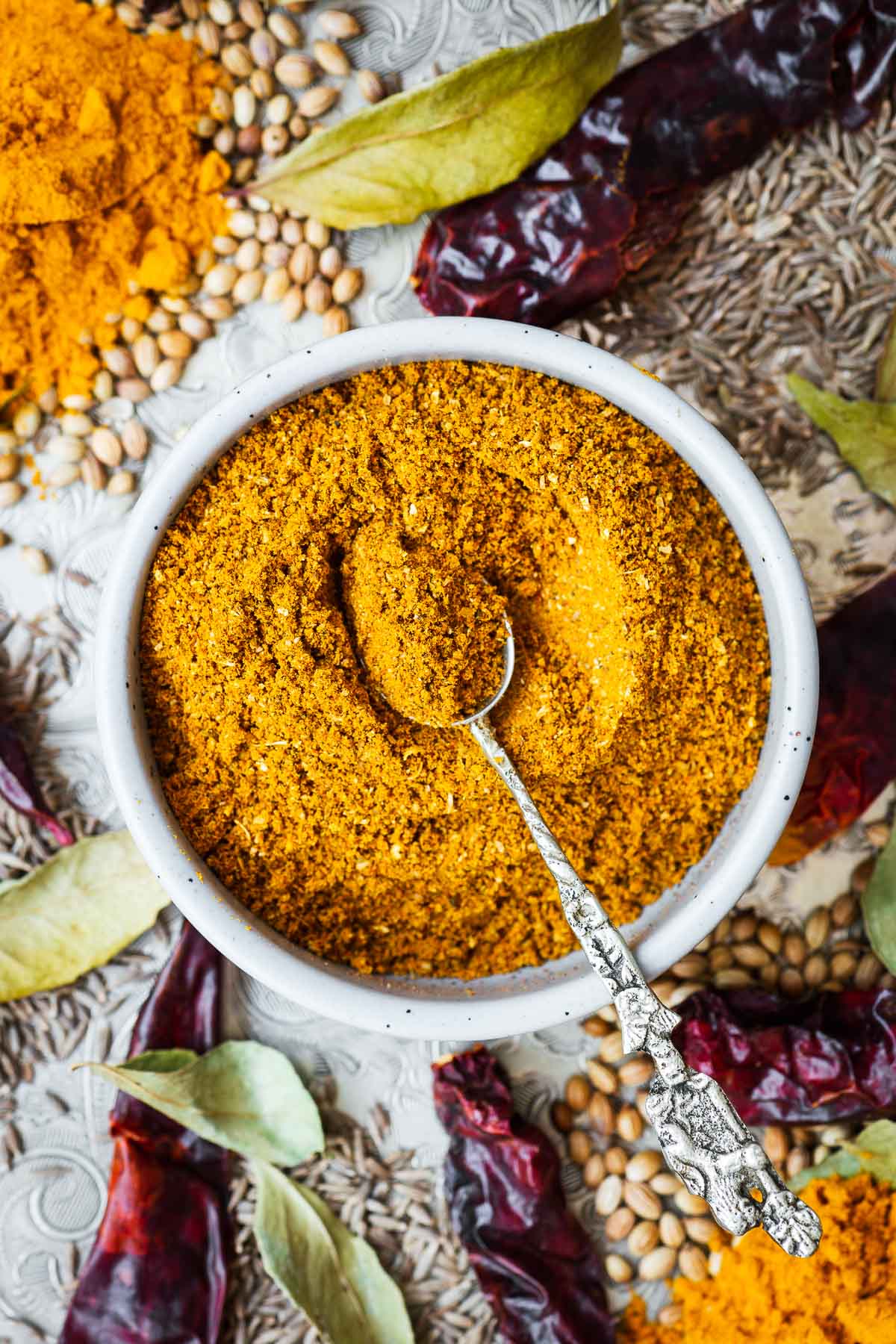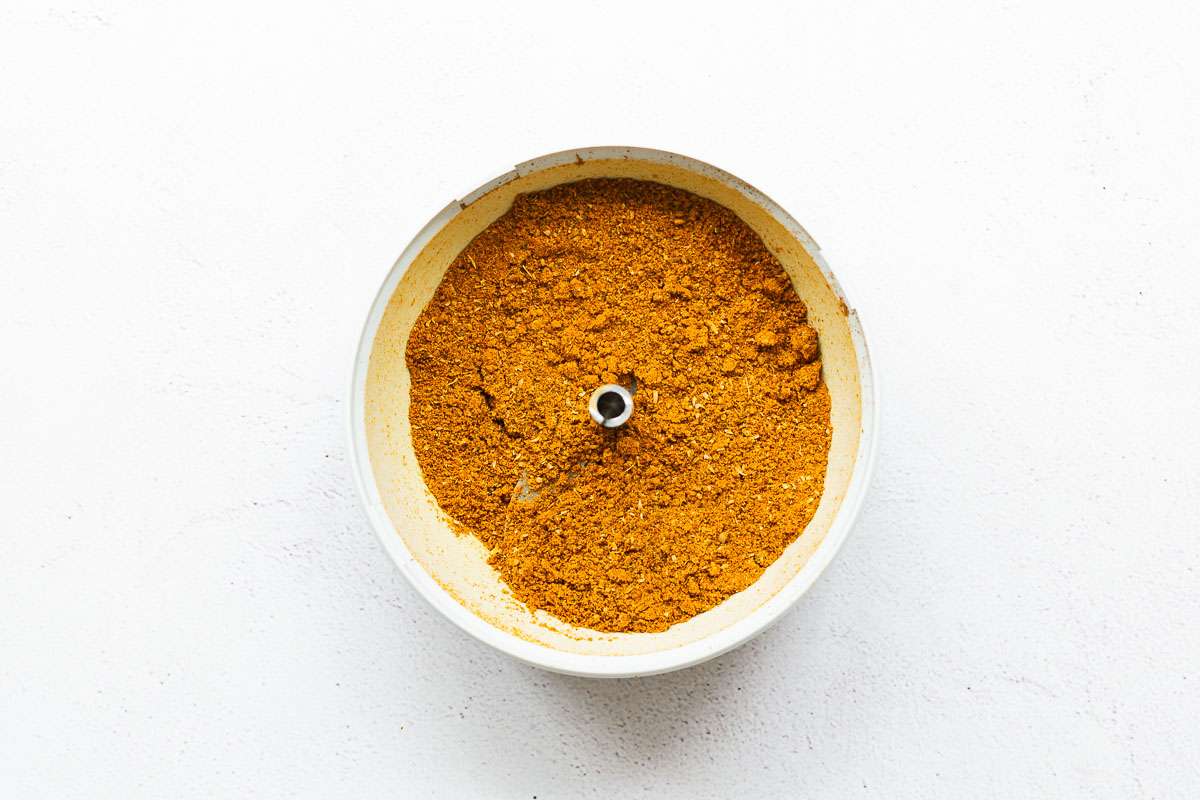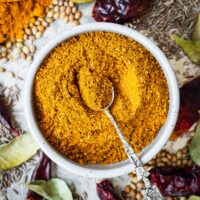The 10 Best Curry Powder Substitutes (+ the Worst)
No curry powder? No worry! This fragrant homemade curry powder spice blend is more flavourful than your average shop-bought curry powder. Or try one of the best curry powder substitutes using whole spices, ground spices or shop-bought spice blends.
Curry powder is a popular blend of spices packed with complex flavours. Most curry powder spice mixes contain coriander, cumin, turmeric, and chilli powder (or paprika) mixed with various spices.
It is a delicious addition to soups, stews and curries. And it’s certainly worth keeping in your spice rack. But, if you find yourself without curry powder, it’s easy to make a great curry powder substitute at home.
The best substitute for curry powder is homemade curry powder using whole spices. But this post also covers simple ground spice mixes and shop-bought alternatives (like garam masala).

Keep reading for all the curry powder information, or jump straight to the section that solves your problem:
A quick history of curry and curry powder
Europeans popularised the word curry during their colonisation of India as a catchall term for the various stews they encountered in Indian cuisine.
And curry powder, as we know it today, was likely conceived as a ready-made ingredient to replicate the flavours of Indian cooking during the British colonial period in India – first sold by Indian merchants to British traders.
Curry powder swept through Britain in the 18th century. And today, it is used as a versatile and flavourful spice blend around the world.
It is not commonly used in traditional Indian cooking. Instead, Indian food relies on individual spices for specific Indian dishes.
What is curry powder?
It is a mix of spices originating from the Indian subcontinent. The spice blend can contain various Indian spices, such as coriander, cumin, turmeric, fennel, fenugreek, chilli powder, paprika, cinnamon, cardamom, cloves, ginger, and nutmeg.
The specific spices vary depending on the recipe and personal taste.
Curry powder can also range in flavour from mild to spicy. The pre-mixed spice blend adds depth and complexity to soups, stews, curries, marinades, and sauces.

Typical curry powder ingredients
Curry powder is a blend of typical Indian spices. The exact ingredients vary greatly, but common ingredients include coriander, cumin, turmeric, chilli powder, paprika, cinnamon, cardamom, cloves and ginger. Some blends also include fennel seeds, mustard seeds, star anise, and even more spices.
The combination of savoury and sweet spices gives this seasoning blend its distinct complex flavour. Whether you use store-bought or homemade curry powder, it is a versatile ingredient that adds loads of flavour.
The curry powder recipe in the recipe card uses whole spices for the freshest curry powder:
- coriander seeds
- cumin seeds
- fennel seeds
- peppercorns
- yellow mustard seeds
- dried curry leaves (or bay leaves)
- ground turmeric
- chilli powder (or flakes)
- ground ginger powder
- ground cinnamon
I only add a small pinch of cinnamon to this curry powder recipe because the flavour can be overpowering. My garam masala spice blend is more cinnamon-forward, if this is what you are looking for.
Additional ingredients can include fenugreek seeds, whole dried chillies, cardamom, garlic powder, and onion powder.
How to make curry powder
As soon as we grind our whole spices, they start to lose their intensity. So, the fresher the ground, the better the flavour. And, if you have a spice grinder, freshly toasted whole spices will make the most flavourful curry powder.
But don’t worry if you don’t have a spice grinder. This post has a variety of curry powder alternatives that won’t need a grinder (like this easy four-ingredient curry powder mix).
Step 1: Get your spices ready
The homemade curry powder blend in the recipe card has a delightfully complex flavour profile thanks to all the different spices. Use as many of these spices as you have at home. But don’t fret if your spice cabinet is not overflowing like mine.
Adjust the spice blend with what you have for an easy curry powder substitute.

Step 2: Toast whole spices.
Add the whole spices to a dry skillet or frying pan and toast until just fragrant – about three minutes. Don’t char the spices. It can result in a burnt flavour.
Set the toasted spices aside to cool down.

Step 3: Blend the spice mix
Put the toasted spices in a spice grinder (or coffee grinder). Add the remaining ground spices and blitz until you have a fine powder.
Have a small taste, and add more chilli powder if you want a spicier curry powder. I prefer mild curry powder. Because you can always add chilli powder directly to dishes to turn up the heat.


The best curry powder substitutes
Curry powder is a staple ingredient in many cuisines and dishes, adding depth, flavour, and heat to any meal. Whether you’re looking to enhance the flavour of soups, stews, or sauces or to spice up your roasted vegetables, a good curry powder can make all the difference.
But what happens when you find yourself in a situation where you don’t have any on hand? How do you achieve that distinct curry powder taste?
We look at the best substitutes for curry powder, including shop-bought ingredients and simple homemade blends.
Find the ideal substitute to fit your pantry and your preference:
- Homemade curry powder (with whole toasted spices)
- Curry powder spice blend (with ground spices)
- Four-ingredient curry powder
- Garam masala (best non-spicy curry powder alternative)
- Tandoori masala
- Sambar powder
- Madras curry powder
- Cumin and coriander
- Turmeric powder
- Curry leaves (+ how to make curry leaf tadka)
1. Homemade curry powder (with whole toasted spices)
This homemade curry powder spice blend is the best substitute for store-bought curry powder. In fact, it is fresher and, therefore, more aromatic. Once you try this curry powder recipe, you will always prefer to make your own curry powder.
The recipe card contains the ingredient list and instructions for homemade curry powder.
But, while this mixture of spices is an improvement on shop-bought curry powder, it does have some drawbacks.
- It requires a spice grinder (or coffee grinder).
- It uses many different spices and requires a well-stocked spice cabinet.
- It is difficult to make small amounts at a time.
If you don’t have a spice grinder, try the curry powder spice blend using ground spices. And if your spice rack is not that well stocked (or you only need a small amount of curry powder substitute), try the four-ingredient curry powder spice blend.
Or keep scrolling until you find YOUR perfect curry powder substitute.

2. Curry powder spice blend (from ground spices)
You can make your own curry powder spice blend from pre-ground spices.
To make roughly five tablespoons of curry powder, mix the ingredients together in a small bowl:
- 2 tablespoons ground coriander
- 1 tablespoon ground cumin
- 1 tablespoon ground turmeric
- 1 teaspoon ground fennel
- 1 teaspoon ground black pepper
- ½ teaspoon mustard powder
- ½ teaspoon Kashmiri chilli powder, or more for hot curry powder
- ½ teaspoon ground ginger
- a pinch of ground cinnamon
Use the spice blend as a direct substitute for curry powder.
3. Four-ingredient curry powder spice blend
This simple spice mix is your best option when you only need a small amount of curry powder. Or if you have limited spices available.
It makes a great substitute for curry powder. And it’s quick and super easy to combine.
Mix one tablespoon of ground coriander with one teaspoon of ground cumin, a teaspoon of ground turmeric, and half a teaspoon of chilli powder (or use paprika for a non-spicy version).
Use this ground spice mix as a direct substitute for curry powder.
4. Garam masala (best non-spicy curry powder alternative)
Garam Masala is a popular spice blend in Indian cuisine, and it can be a good substitute for curry powder in a pinch. It contains many of the same ingredients as curry powder, including coriander, cumin, cinnamon, cardamom, and black pepper.
However, it is milder with more sweet spices when compared to curry powder. It makes garam masala a great shop-bought alternative if you want to tone down the spiciness of your dish.
Another major difference between the two spice blends is the lack of turmeric in garam masala. Turmeric is a key ingredient in curry powder. It creates that characteristic golden hue and distinct curry powder flavour.
Garam masala is a good substitute if you want a less spicy alternative. But it’s a better substitute with some ground turmeric. Use roughly one teaspoon of turmeric for every tablespoon of garam masala.
And add a pinch of cayenne pepper to the garam masala to add some curry powder heat.

5. Tandoori masala
Tandoori masala (or tandoori sauce) contains a spice blend intended for Indian cooking with a tandoor (clay oven).
The spice mix varies across regions but generally includes coriander, cumin, garlic powder, ginger, cloves, mace, fenugreek, cinnamon, black pepper, cardamom, and nutmeg. It can also contain the garam masala spice blend.
Tandoori masala is spicier and more pungent than mild curry powder. But it makes a good alternative in a pinch.
Use half a teaspoon of tandoori masala to substitute a teaspoon of curry powder. Add more after tasting.
6. Sambar powder
Sambar powder is an essential ingredient in South Indian cooking made from various toasted Indian spices like coriander, fenugreek and mustard seeds with dal.
Each region, family and household can have their own unique variation of this spice blend.
Thanks to the chana dal and toor dal, sambar powder has a much more earthy flavour.
But it’s a good option if you’ve run out of curry powder. Use it as a direct substitute but add some ground cumin, turmeric and chilli powder (or paprika) for a closer flavour profile.
7. Madras curry powder
Madras curry powder is another popular blend of Indian spices. The exact ingredients used in Madras curry powder can vary, but it typically includes coriander, cumin, turmeric, fenugreek, mustard seeds, and chile.
Madras sauce is a fairly hot curry sauce. And it is used in vegetable and meat dishes, served with cooling raita on the side.
Since Madras curry powder is much spicier than mild Western curry powder, start with half a teaspoon of Madras curry powder as a substitute for a teaspoon of curry powder.
Use this Madras curry powder recipe to make your own spice blend.

8. Cumin and coriander
Cumin and coriander are two common spices included in most curry powder blends. Use them on their own as an easy substitute for curry powder.
Together, these two spices can help you achieve a similar flavour profile to curry powder even though it will lack the complexity of a good curry powder.
Mix two teaspoons of ground coriander with a teaspoon of ground cumin for one tablespoon of curry powder substitute. Add a pinch of cayenne pepper if you want it spicy.
9. Turmeric powder
Ground turmeric is a key ingredient in curry powder. It gives curry powder its bright yellow colour and contributes to the distinct taste of curry powder.
If you want to add a touch of curry flavour to your dish, consider turmeric as a simple substitute. It’s also a good non-spicy alternative to curry powder.
Turmeric has a mild earthy flavour and a golden hue. But it lacks the complexity of shop-bought curry powder. Use it as a 1:1 substitute for curry powder or add more common spices, like cumin, coriander, cardamom and cinnamon for a deeper flavour.
10. Curry leaves (+ curry leaf tadka directions)
Curry leaves are often used in South Indian cuisine and can add a unique, aromatic flavour to dishes. It does not taste like curry powder. But it will give your meal an authentic Indian flavour.
Nowadays, you can find curry leaves in the grocery store, sold fresh or dried.
The most popular way to use curry leaves is in tempering. The spice-infused oil is also called tadka.
Make a curry leaf tadka with fresh or dried curry leaves:
- Heat a tablespoon of ghee (or oil) in a small pan over medium heat until it shimmers.
- Add half a teaspoon of cumin seeds and half a teaspoon of mustard seeds. Fry until the spices are fragrant and begin to pop.
- Add half a teaspoon of minced garlic and cook until golden – for a minute or two.
- Then, add 5 to 7 curry leaves and cook for a few seconds until the curry leaf crisps up.
Stir the curry leaf tadka (tempering) into cooked dal or curry. Tempering is an essential step in authentic Indian dal.
Don’t use chaat masala as a substitute for curry powder in cooking
You might think that because garam masala is on the list of the best substitutes, chaat masala will also make the cut. But don’t use chaat masala as a direct curry powder substitute in cooking.
Masala refers to any ground spice mix. Chaat masala and garam masala are both Indian spice blends, but they are not the same. They have completely different flavour profiles.
Chaat masala is tart and pungent. It contains amchoor (dried mango powder), cumin, coriander, ground ginger, salt (often the sulphuric black salt called kala namak), black pepper, asafoetida, and chilli powder.
Want a seasoning blend to sprinkle over fresh fruit and other snacks? Then chaat masala is your mix.
But don’t use chaat masala as a substitute for curry powder in soups, stews and curries. It is not a good curry powder substitute in these savoury dishes.

Frequently asked questions
Curry powder is a blend of ground Indian spices. The exact ingredients vary depending on geography and personal taste, but typical spices include coriander, cumin, turmeric, chilli powder, paprika, cinnamon, cardamom, cloves and ginger powder. Some blends also include fennel seeds, mustard seeds, star anise, and more.
For an easy curry powder substitute, mix one tablespoon of ground coriander with one teaspoon of ground cumin, a teaspoon of ground turmeric, and half a teaspoon of chilli powder (or use paprika for a non-spicy version). Use the spice mix in place of curry powder.
Garam masala and curry powder are both ground spice blends with common Indian spices. But garam masala has a warmer flavour profile without the spiciness. Add a pinch of chilli powder, turmeric and ground cumin for a better substitute or use as is for a non-spicy curry powder alternative.
Paprika does not have the complexity of curry powder. But you can mix two teaspoons of ground coriander, a teaspoon of ground cumin, and half a teaspoon of turmeric with half a teaspoon of paprika for a non-spicy alternative to curry powder.
Curry powder is a staple ingredient for households globally, but there is no need to worry if you’ve run out. Make your own aromatic curry powder, or try one of the several great curry powder substitutes.
Experiment with different combinations of spices and get creative in the kitchen. Let me know which substitute worked best for you in the comments below!

Equipment
- Skillet (or frying pan)
Ingredients
- 2 tablespoons coriander seeds
- 1 tablespoon cumin seeds
- 1 teaspoon fennel seeds
- 1 teaspoon black peppercorns
- 1 teaspoon yellow mustard seeds
- 2 dried curry leaves, or 1 bay leaf
- 1 tablespoon turmeric
- ½ to 1 teaspoon Kashmiri chilli powder, or red pepper flakes
- ½ teaspoon ground ginger
- a pinch of ground cinnamon
Instructions
- Heat a dry skillet over medium heat and toast the whole spices (coriander, cumin, fennel, peppercorns, mustard) and dried curry leaves (or bay leaf) for 3 minutes until fragrant. Transfer the toasted spices to a bowl and leave them to cool.
- Add the toasted spices to a spice grinder (or coffee grinder). Blitz with the remaining ground spices until the mixture resembles curry powder.
- Store the homemade curry powder in an airtight container in a cool, dark place. It can keep for up to 6 months, but it’s best used within 4 weeks.
Notes
- Use as many of the ingredients as you have at home for a fragrant, complex curry powder. Adjust the recipe to fit your pantry and your preference, and make this spice blend your own.
- You can substitute ground spices if you don’t have whole spices. Add them to the dry skillet for the last 30 seconds of toasting.
- This recipe is easy to double if you prefer to make a larger batch.
- If you don’t have a spice grinder, the post includes a recipe for a curry powder blend using pre-ground spices and a super simple four-ingredient curry powder substitute. Or try another great curry powder substitute.
